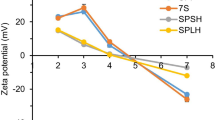Abstract
A study was conducted to evaluate the potential of soy protein-based plywood glues for foam extrusion. Foaming properties were the first criterion used to screen several soy protein sources. Foaming capacities and stabilities of glue mixes containing animal blood (control) or soy products (meals, flours, concentrates, and isolates) were compared and correlated with molecular weights and surface hydrophobicity indices (S o) in an attempt to identify structure/function relationships. The blood-based glue mix produced more foam than any of the soy-based glues. Soy flours and concentrates generally produced greater foam volumes and more stable foams than soy meal and isolates. Differences in foaming properties could not be explained by solubility profiles or S o. However, results of gel electrophoresis indicated that soy products with poor foaming properties had extensive structure modifications or contained considerably lesser amounts of protein available for foaming reactions. Glue mixes containing the soy flours ISU-CCUR, Honeysoy 90, Nutrisoy 7B, and defatted Soyafluff and the soy concentrates Arcon F, ISU-CCUR, and Procon 2000 demonstrated the desired mixing and foaming properties for foam extrusion.
Similar content being viewed by others
References
Sellers, T., Jr., Adhesive Application, Plywood and Adhesive Technology, Marcel Dekker Inc., New York, 1985, pp. 151–236.
Kinsella, J.E., Functional Properties of Soy Proteins, J. Am. Oil Chem. Soc. 56:242–258 (1979).
German, J.B., T.E. O'Neill, and J.E. Kinsella, Film Forming and Foaming Behavior of Food Proteins, Ibid. 62:1358–1366 (1985).
Vani, B., and J.F. Zayas, Foaming Properties of Selected Plant and Animal Proteins, J. Food Sci. 60:1025–1028 (1995).
American Oil Chemists' Society, Official Methods and Recommended Practices of the American Oil Chemists' Society, 5th edn., AOCS Press, Champaign, 1998.
Sorgentini, D.A., J.R. Wagner, and M.C. Añon, Effects of Thermal Treatment of Soy Protein Isolate on the Characteristics and Structure-Function Relationship of Soluble and Insoluble Fractions, J. Agric. Food Chem. 43:2471–2479 (1995).
Wolf, W.J., and T.C. Nelsen, Partial Purification and Characterization of the 15S Globulin of Soybeans, a Dimer of Glycinin, Ibid. 44:785–791 (1996).
Fling, S.P., and D.S. Gregerson, Peptide and Protein Molecular Weight Determination by Electrophoresis Using a High-Molarity Tris Buffer System Without Urea, Anal. Biochem. 155:83–88 (1986).
Wolf, W.J., Soybeans and Other Oilseeds, in Encyclopedia of Chemical Technology, 4th edn., John Wiley & Sons, Inc., New York, 1997, Vol. 22, pp. 591–619.
Bain, W.M., S.J. Circle, and R.A. Olson, Isolated Soy Proteins for Paper Coating, in Synthetic and Protein Adhesives for Paper Coating, Technical Association of the Pulp and Paper Industry (TAPPI) Monograph Series No. 22, 1961, pp. 206–241.
Olson, R.A., and P.T. Hoelderle, Isolated Soy Protein Binders for Paper and Paperboard Coatings, TAPPI Monograph Series No. 36, Badger Printing Division, Appleton, WI, 1975, pp. 75–96.
Nakai, S., Structure-Function Relationships of Food Proteins with an Emphasis on the Importance of Protein Hydrophobicity, J. Agric. Food Chem. 31:676–683 (1983).
Kinsella, J.E., and L.G. Phillips, Structure: Function Relationships in Food Proteins, Film and Foaming Behavior, in Food Proteins, edited by J.E. Kinsella and W.G. Soucie, American Oil Chemists' Society, Champaign, 1989, pp. 52–77.
Kato, A., K. Komatsu, K. Fujimoto, and K. Kobayashi, Relationship Between Surface Functional Properties and Flexibility of Proteins Detected by the Protease Susceptibility, J. Agric. Food Chem. 33:931–934 (1985).
Townsend, A., and S. Nakai, Relationships Between Hydrophobicity and Foaming Characteristics of Food Proteins, J. Food Sci. 48:588–594 (1983).
Horiuchi, T., D. Fukushima, H. Sugimoto, and T. Hattori, Studies on Enzyme-Modified Proteins as Foaming Agents: Effect of Structure on Foam Stability, Food Chem. 3:35–42 (1978).
Hayakawa, S., and S. Nakai, Relationships of Hydrophobicity and Net Charge to the Solubility of Milk and Soy Proteins, J. Food Sci. 50:486–491 (1985).
Author information
Authors and Affiliations
Corresponding author
About this article
Cite this article
Hojilla-Evangelista, M.P., Dunn, L.B. Foaming properties of soybean protein-based plywood adhesives. J Amer Oil Chem Soc 78, 567–572 (2001). https://doi.org/10.1007/s11746-001-0305-0
Received:
Accepted:
Issue Date:
DOI: https://doi.org/10.1007/s11746-001-0305-0




